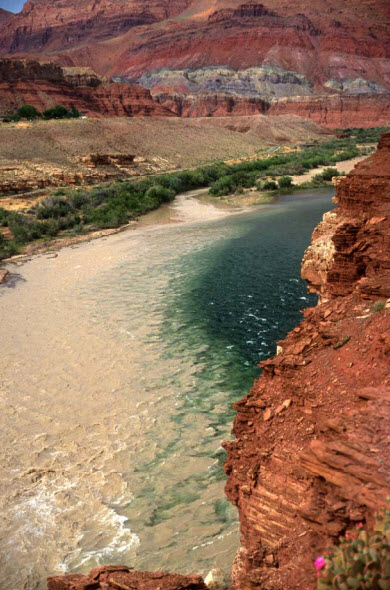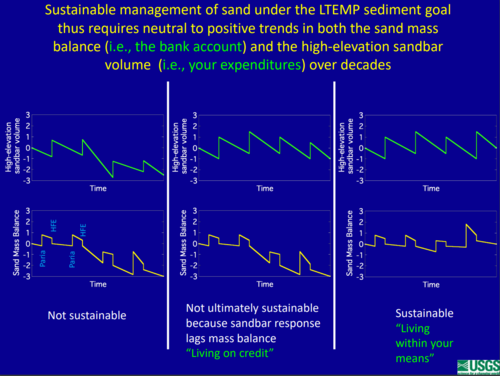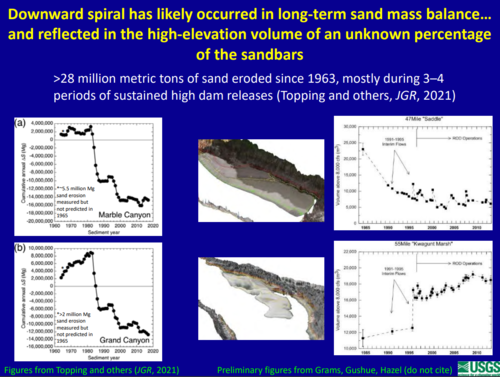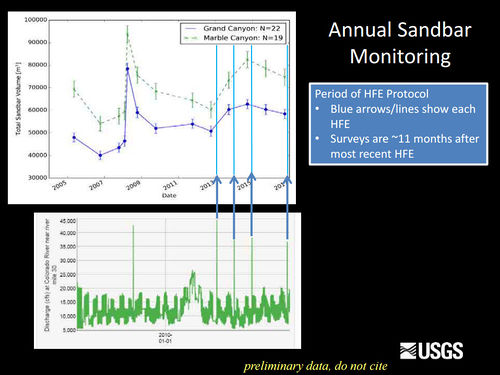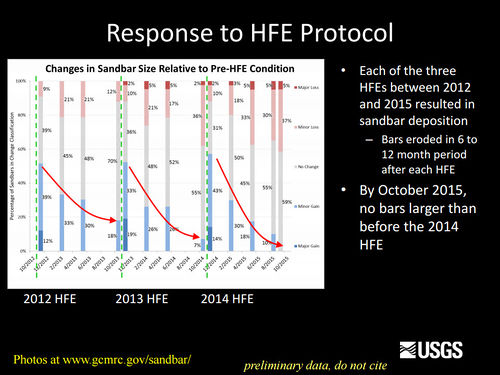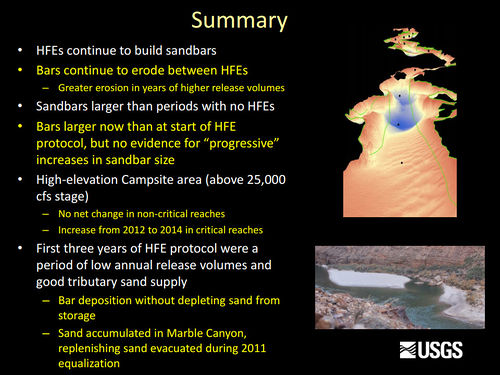Difference between revisions of "GCDAMP Sediment"
Cellsworth (Talk | contribs) |
Cellsworth (Talk | contribs) |
||
| (14 intermediate revisions by the same user not shown) | |||
| Line 54: | Line 54: | ||
|class="MainPageBG" style="width:55%; border:1px solid #cef2e0; background:#f5faff; vertical-align:top; color:#000;"| | |class="MainPageBG" style="width:55%; border:1px solid #cef2e0; background:#f5faff; vertical-align:top; color:#000;"| | ||
{|width="100%" cellpadding="2" cellspacing="5" style="vertical-align:top; background:#f5faff;" | {|width="100%" cellpadding="2" cellspacing="5" style="vertical-align:top; background:#f5faff;" | ||
| − | ! <h2 style="margin:0; background:#cedff2; font-size:120%; font-weight:bold; border:1px solid #a3bfb1; text-align:left; color:#000; padding:0.2em 0.4em;"> | + | ! <h2 style="margin:0; background:#cedff2; font-size:120%; font-weight:bold; border:1px solid #a3bfb1; text-align:left; color:#000; padding:0.2em 0.4em;"> Sediment transport and river discharge </h2> |
| − | + | ||
|- | |- | ||
|style="color:#000;"| | |style="color:#000;"| | ||
| − | + | When the discharge of the Colorado River was lower than about 9,000 ft3/s, sand accumulated in the reach in Marble and upper Grand Canyons. At discharges higher than about 9,000 ft3/s, however, sand-transport rates at the Grand Canyon gaging station generally equaled those at the Lees Ferry gaging station, and at discharges higher than about 16,000 ft3/s, sand-transport rates at the Grand Canyon gaging station generally either equaled or exceeded those at the Lees Ferry gaging station. Thus, at discharges greater than about 9,000 ft3/s, sand was either conveyed through or eroded from the reach in Marble and upper Grand Canyons. | |
| − | [ | + | As discharges less than 9,000 ft3/s became less common, the discharge of the river became progressively more conducive to the conveyance of sand through or the erosion of sand from Marble and upper Grand Canyons. [https://pubs.usgs.gov/pp/pp1677/pdf/pp1677.pdf] |
| − | + | |- | |
| + | ! <h2 style="margin:0; background:#cedff2; font-size:120%; font-weight:bold; border:1px solid #a3b0bf; text-align:left; color:#000; padding:0.2em 0.4em;"> How long is sand stored on the bed of the river? </h2> | ||
| + | |- | ||
| + | |style="color:#000;"| | ||
| − | + | Bedrock-canyon rivers tend to be supply limited because they are efficient transporters of sediment and not because the upstream supply of sediment is small. Following episodic tributary floods that supply finer sand, sand migrates quickly downstream in the form of a wave in which large systematic changes in bed-sand grain size occur. The tributary fine-sediment (i.e., sand, silt, and clay) supply to the Colorado River in our study area is bimodal, with a clay primary mode and a sand-silt secondary mode. The tributary sand supply grades smoothly into the silt-and-clay supply such that the sand-size sediment comprises the coarser part of this secondary mode, which occurs in very fine sand (0.0625–0.125 mm) for the Paria River and in medium silt (0.0156–0.0312 mm) for the LCR. Both tributaries supply more silt and clay to the Colorado River than they do sand. During sediment years 1998–2017, silt and clay comprised 60.6% and 88.1% of the fine sediment supplied by the Paria River and LCR, respectively. Of the total amount of sand supplied since 2011, the Paria River has contributed 57%, the LCR has contributed 21%, and all other tributaries combined have contributed 22%. The largest quantities of sand are supplied by the Paria River and LCR during summer thunderstorm-generated floods that last hours to a day. Large sand loads are rare during winter and spring months on both rivers. | |
| − | + | Our late-1990s observations suggested that tributary floods generated sand waves that split into two packets, A and B: packet A was finer than packet B and migrated downstream in the Colorado River with a celerity slightly slower than the water velocity. Packet B migrated much more slowly than packet A; the amalgamated front of packet B had migrated only ∼10 km in the 3 and 10 days after two Paria River floods. The primary peak in QSAND—1/βQ cross covariance decays to background within 7–20 days of a tributary flood at all but the RK49 station, thus indicating that much of packet A exits our study area quickly. The lower celerity of packet B causes the secondary cross-covariance peak to become distinct from the primary peak with increasing distance downstream. '''Following a Paria River flood, the secondary peak (packet B) separates from the primary peak (packet A) between the RK49 and RK99 stations, and it takes ∼198 and ∼290 days for the tail of packet B to respectively reach these stations. Following an LCR flood, packet B separates from packet A upstream from the RK141 station, and it takes ∼261 days for the tail of packet B to reach this station.''' [https://agupubs.onlinelibrary.wiley.com/doi/epdf/10.1029/2020JF005565] | |
|- | |- | ||
| − | ! <h2 style="margin:0; background:#cedff2; font-size:120%; font-weight:bold; border:1px solid #a3b0bf; text-align:left; color:#000; padding:0.2em 0.4em;"> | + | ! <h2 style="margin:0; background:#cedff2; font-size:120%; font-weight:bold; border:1px solid #a3b0bf; text-align:left; color:#000; padding:0.2em 0.4em;"> Updates </h2> |
|- | |- | ||
|style="color:#000;"| | |style="color:#000;"| | ||
| − | + | [[File:SedimentSustainability.PNG|center|thumbnail|500px|https://www.usbr.gov/uc/progact/amp/twg/2022-01-13-twg-meeting/20220113-AnnualReportingMeeting-ProjectA-StreamflowWaterQualitySedimentTransportBudgetingColoradoRiverEcosystem-508-UCRO.pdf ]] | |
| − | + | [[File:LongtermDecline.PNG|center|thumbnail|500px|https://www.usbr.gov/uc/progact/amp/twg/2022-01-13-twg-meeting/20220113-AnnualReportingMeeting-ProjectA-StreamflowWaterQualitySedimentTransportBudgetingColoradoRiverEcosystem-508-UCRO.pdf ]] | |
| + | |||
| + | [[File:SandbarMonitoring2016.jpg|center|thumbnail|500px|[https://www.usbr.gov/uc/rm/amp/twg/mtgs/17jan26/AR3_Grams.pdf https://www.usbr.gov/uc/rm/amp/twg/mtgs/17jan26/AR3_Grams.pdf] ]] | ||
| + | |||
| + | [[File:2012 2014 HFE response.jpg|center|thumbnail|500px|[https://www.usbr.gov/uc/rm/amp/twg/mtgs/15jun11/Attach_02,.pdf https://www.usbr.gov/uc/rm/amp/twg/mtgs/15jun11/Attach_02,.pdf] ]] | ||
| + | |||
| + | [[File:2016 SedimentSummary.jpg|center|thumbnail|500px|[https://www.usbr.gov/uc/rm/amp/twg/mtgs/16jan26/documents/AR02_Grams.pdf https://www.usbr.gov/uc/rm/amp/twg/mtgs/16jan26/documents/AR02_Grams.pdf] ]] | ||
|} | |} | ||
| Line 164: | Line 172: | ||
|- | |- | ||
|style="color:#000;"| | |style="color:#000;"| | ||
| + | |||
| + | '''2024''' | ||
| + | *[https://www.usbr.gov/uc/progact/amp/amwg/2024-02-29-amwg-meeting/20240229-ProjectB-UpdateRiverbedSandbarResponseDamOperationsHFE-508-UCRO.pdf Project B Update and Riverbed and sandbar response to dam operations and high-flow experiments ] | ||
| + | *[https://www.usbr.gov/uc/progact/amp/amwg/2024-02-29-amwg-meeting/20240229-ProjectA-StreamflowWaterQualitySedimentTransportBudgetingColoradoRiverEcosystem-508-UCRO.pdf Project A: Streamflow, Water Quality, and Sediment Transport and Budgeting in the Colorado River Ecosystem ] | ||
| + | *[https://www.usbr.gov/uc/progact/amp/twg/2024-01-25-twg-meeting/20240125-AnnualReportingMeeting-EffectsDamOperationsVegetationManagementPreservationGeomorphicConditionArchaeologicalSites-508-UCRO.pdf Effects of Reservoirs and Stock Ponds on Surface Water Runoff in the Little Colorado River Basin ] | ||
| + | *[[Media:Sartain_AGU2023_poster_ARM.pdf| Assessing geomorphic change for 454 river km of the Colorado River in Grand Canyon, AZ via continuous and high-resolution water surface and bed profiles | ||
| + | ]] | ||
| + | *[[Media:Kaplinski_Glen_canyon_flow_model_poster_20240114.pdf| Hydrodynamic modeling of the Colorado River between Glen Canyon Dam and Lees Ferry, Arizona]] | ||
| + | |||
| + | '''2024''' | ||
| + | *[https://doi.org/10.3133/ofr20231093 Griffiths et al., 2024, Changes in sand storage in the Colorado River in Grand Canyon National Park from July 2017 through June 2020] | ||
| + | *[https://www.usbr.gov/uc/progact/amp/twg/2024-01-25-twg-meeting/20240125-AnnualReportingMeeting-ChannelResponseHighFlowsWesternGrandCanyon-508-UCRO.pdf Channel Response to High Flows in Western Grand Canyon ] | ||
| + | *[https://www.usbr.gov/uc/progact/amp/twg/2024-01-25-twg-meeting/20240125-AnnualReportingMeeting-ProjectAStreamflowWaterQualitySedimentTransportBudgetingColoradoRiverEcosystem-508-UCRO.pdf Project A: Streamflow, Water Quality, and Sediment Transport and Budgeting in the Colorado River Ecosystem ] | ||
| + | *[https://www.usbr.gov/uc/progact/amp/twg.html#:~:text=Project%20B%20Update%20and%20Riverbed%20and%20sandbar%20response%20to%20dam%20operations%20and%20high%2Dflow%20experiments Project B Update and Riverbed and sandbar response to dam operations and high-flow experiments ] | ||
| + | |||
| + | '''2023''' | ||
| + | *[https://www.usbr.gov/uc/progact/amp/twg/2023-01-26-twg-meeting/20230126-AnnualReportingMeeting-AContinuousHigh-ResolutionProfileRiverbedWaterSurface460-kmColoradoRiverGrandCanyon-508-UCRO.pdf A Continuous High-Resolution Profile of the Riverbed and Water Surface for 460-km of the Colorado River in Grand Canyon] | ||
| + | *[https://www.usbr.gov/uc/progact/amp/twg/2023-01-26-twg-meeting/20230126-AnnualReportingMeeting-StreamflowSedimentVegetationDynamics-508-UCRO.pdf Project A: Streamflow, Sediment, and Vegetation Dynamics; Implications for Geomorphic Change in the Colorado River and its Tributaries] | ||
| + | *[https://www.usbr.gov/uc/progact/amp/twg/2023-01-26-twg-meeting/20230126-AnnualReportingMeeting-StreamflowWaterQualitySedimentTransportBudgetingColoradoRiverEcosystem-508-UCRO.pdf Project A: Streamflow, Water Quality, and Sediment Transport and Budgeting in the Colorado River Ecosystem] | ||
| + | *[[Media:ARM_salter.pdf| Numerical Modeling of Mud Transport, Storage, and Release on the Colorado River, Arizona]] | ||
'''2022''' | '''2022''' | ||
| Line 171: | Line 199: | ||
'''2021''' | '''2021''' | ||
| + | *[[Media:Glen Canyon Sand Augmentation White Paper.pdf| Argonne. 2021. Evaluation of Sand Augmentation for Stabilizing Recreational Beaches and Storing Sand in Glen Canyon National Recreation Area]] | ||
*[https://www.usbr.gov/uc/progact/amp/twg/2021-10-14-twg-meeting/20211014-MorphodynamicModelEvaluateSandbarRebuilding-Presentation-508-UCRO.pdf A simple morphodynamic model to rapidly evaluate sandbar rebuilding during controlled floods] | *[https://www.usbr.gov/uc/progact/amp/twg/2021-10-14-twg-meeting/20211014-MorphodynamicModelEvaluateSandbarRebuilding-Presentation-508-UCRO.pdf A simple morphodynamic model to rapidly evaluate sandbar rebuilding during controlled floods] | ||
*[https://doi.org/10.1029/2020JF005565 Topping et al. 2021, Self-limitation of sand storage in a bedrock-canyon river arising from the interaction of flow and grain size: Journal of Geophysical Research: Earth Surface] | *[https://doi.org/10.1029/2020JF005565 Topping et al. 2021, Self-limitation of sand storage in a bedrock-canyon river arising from the interaction of flow and grain size: Journal of Geophysical Research: Earth Surface] | ||
Latest revision as of 16:05, 16 December 2024
|
|
Sediment and GeomorphologyErosion of sandbars (beaches) along the Colorado River in Grand Canyon was first reported in the early 1970s, approximately 10 years after completion of Glen Canyon Dam. Since then, scientific studies have been conducted to monitor changes in sandbars and changes in the amount of sand stored on the bed of the river. One of the outcomes of these studies has been the implementation of flow experiments intended to rebuild eroded sandbars, especially by the release of controlled floods, also called High Flow Experiments, or HFEs, from Glen Canyon Dam. The sediment and geomorphology projects at Grand Canyon Monitoring and Research Center include the collection and processing of data to provide information needed to conduct controlled floods and to evaluate the outcome of each controlled flood and the long-term effects of controlled floods and normal dam operations on sediment-related resources. [1] Beginning in 1998, recreational campsite area has also been measured on a subset of the sandbar monitoring sites. Campsite areas are defined as areas that are flat (less than 8 degree slope), smooth (not rocky), and clear of dense vegetation. Monitoring data show that vegetation expansion and sandbar erosion/deposition contribute to reductions in campsite area. LTEMP Resource Goal for SedimentIncrease and retain fine sediment volume, area, and distribution in the Glen, Marble, and Grand Canyon reaches above the elevation of the average base flow for ecological, cultural, and recreational purposes. Desired Future Condition for Sediment-Related ResourcesHigh elevation open riparian sediment deposits along the Colorado River in sufficient volume, area, and distribution so as to provide habitat to sustain native biota and desired ecosystem processes |
| --- |
--- |
--- |
|---|
